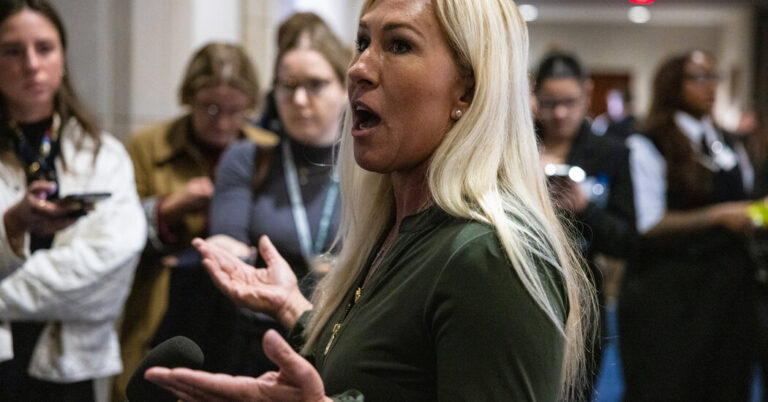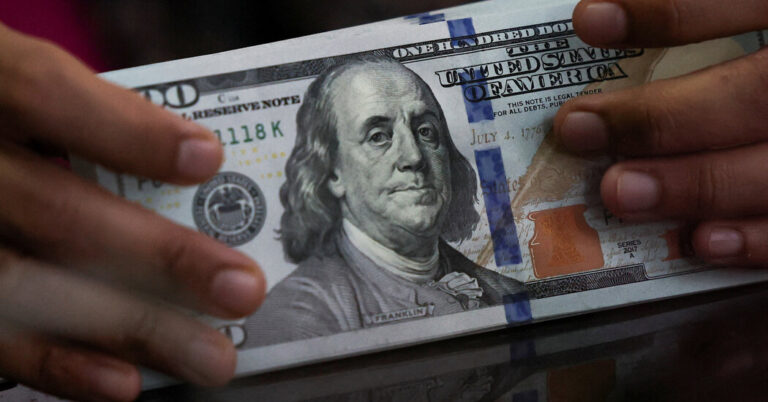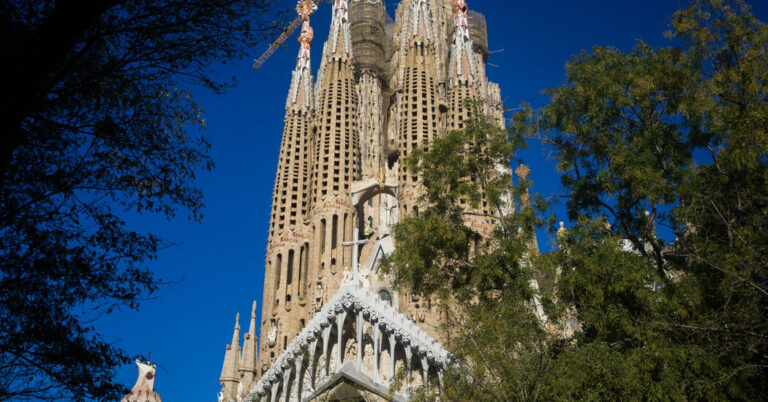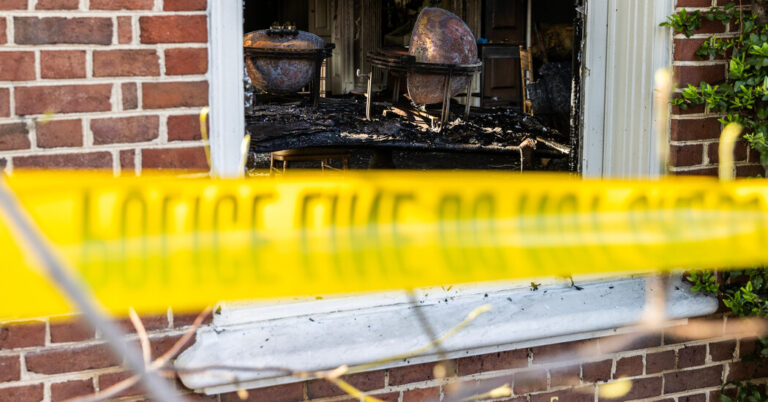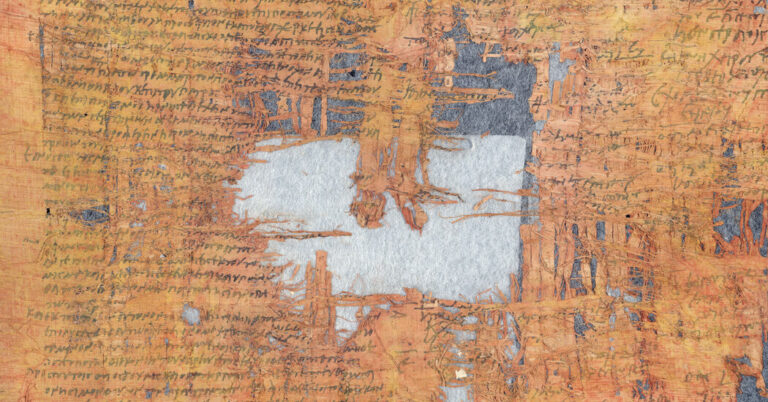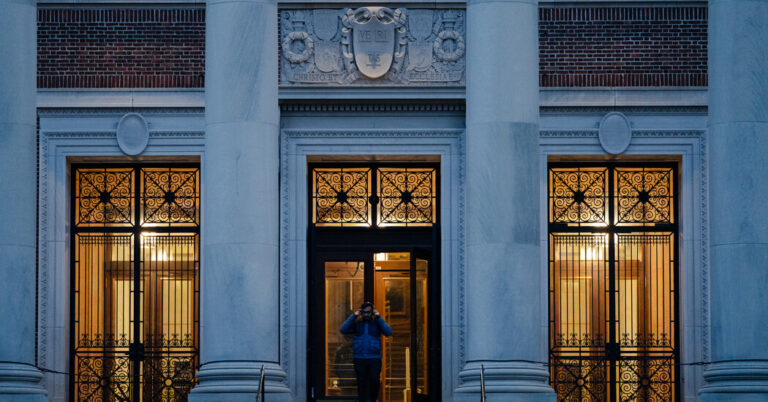Representative Marjorie Taylor Greene, Republican of Georgia, disclosed on Monday that she had purchased between tens and hundreds of thousands of dollars worth of stock on April 8 and 9, the day before and the day of President Trump’s announcement that he was pausing a sweeping set of global tariffs, a pivot that sent the stock market soaring out of a sizable slump.
Ms. Greene bought between about $21,000 and $315,000 in stocks on those days. The day before Mr. Trump’s move, she also dumped between $50,000 and $100,0000 in Treasury bills, according to required public disclosures made to the House.
The report came as Democrats in Congress have demanded investigations of whether the president’s whipsawing moves on trade might have been aimed at manipulating the market and giving his allies a lucrative opportunity for insider trading.
Members of Congress are required to report their stock trades within 30 days of making them, though they only have to mark down broad ranges rather than specific dollar amounts. Ms. Greene’s April 8 and 9 trades — 21 each in the range of $1,001 to $15,000 — are some of the first among members of Congress that will be reported over the coming month as lawmakers detail their financial moves around the time the president encouraged people to buy the dip ahead of his pause on tariffs.
“THIS IS A GREAT TIME TO BUY!!!” Mr. Trump wrote on social media the morning of April 9. About four hours later, he said he was pausing most tariffs on every country except China, an announcement that resulted in massive one-day gains in stocks.
Ms. Greene, one of Mr. Trump’s most loyal allies in the House and an active stock trader, appeared to heed the advice, making an unusually large volume of stock purchases. That day, she bought stock in several companies, including Apple, which has since gone up in value by about 5 percent. She also bought stock in other technology companies, as well as energy firms such as Devon Energy Corporation and the pharmaceutical giant Merck & Company, according to her public disclosures.
The day before, she purchased stock in Palantir, whose value has since gone up 19 percent, and in Advanced Micro Devices, Inc., whose stock has since risen 21 percent. She also sold the Treasury bills as government bond yields were rising amid the tariff chaos, (Ms. Greene had previously purchased up to $500,000 in Treasuries before April 2, when Mr. Trump announced his most expansive tariffs to date.)
Ms. Greene, who is the chairwoman of the DOGE subcommittee of the House Oversight Committee, did not respond to a request for comment. When her stock trades were examined in the past, she told The Atlanta-Journal Constitution that she relies on a financial adviser to trade on her behalf and does not have input on which companies are being traded, or when.
Lawmakers in both parties have long championed legislation to ban individual stock trading by members of Congress as a way to appeal to growing populist sentiment among constituents.
The tumult in the stock market caused by Mr. Trump’s erratic moves on tariffs has led Democrats to question who is gaining financially because of it. Ms. Greene is not alone in appearing to have capitalized on the market volatility.
Representative Rob Bresnahan, a Pennsylvania Republican who has emerged as one of the most active stock traders in the freshman class despite saying during his campaign that he wanted to ban congressional stock trading, also appears to have profited from Mr. Trump’s tariffs.
Mr. Bresnahan sold up to $50,000 in Alibaba stock on March 4, the same day Mr. Trump doubled the tariff on Chinese imports to 20 percent. Alibaba is an e-commerce giant with close ties to the Chinese Communist Party. The stock price rose by about 30 percent between Mr. Bresnahan’s initial purchase and his final sale.
A spokeswoman for Mr. Bresnahan said that he relies on a financial adviser to trade stocks for him, and never knows about the trades before they happen or when they occur. The Alibaba trade, she said, was part of a larger strategic stock package. When it was reported in his disclosure, Mr. Bresnahan’s team put in guardrails so that he would not be able to trade that stock again.
While there has been no evidence of insider trading, Democrats have zeroed in on the potential for malfeasance as a way to attack Mr. Trump’s tariff moves and suggest that he and his friends are exploiting decisions that have hurt ordinary people.
“It is unconscionable that as American families are concerned about their financial security during this economic crisis entirely manufactured by the president, insiders may have actively profited from the market volatility and potentially perpetrated financial fraud on the American public,” a group of Democrats led by Senators Adam Schiff of California and Ruben Gallego of Arizona wrote in a letter last week to Paul Atkins, the chairman of the Securities and Exchange Commission.
In the letter, they demanded that Mr. Atkins open an investigation to determine whether Mr. Trump or any “insiders” had engaged in insider trading or other securities law violations.
Separately, Representative Alexandria Ocasio-Cortez, Democrat of New York, wrote in a fund-raising appeal on April 11 that “any member of Congress who purchased stocks in the last 48 hours should probably disclose that now,” after Nasdaq call volume spiked ahead of Mr. Trump’s announcement. Ms. Ocasio-Cortez has been a longtime proponent of legislation to ban stock trading for members of Congress.


